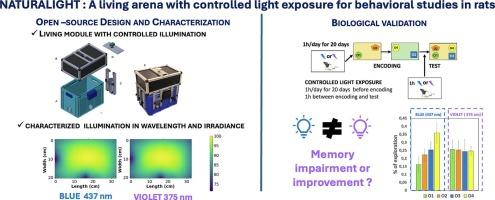Naturalight: A controlled illuminated environment to study light exposure impact on behavior and cognition in freely moving rats
IF 2.1
Q3 ENGINEERING, ELECTRICAL & ELECTRONIC
引用次数: 0
Abstract
In humans, scientific studies have shown that the increased use of screens at night and prolonged exposure to artificial light, particularly blue light, can significantly disrupt the organization of sleep-wake cycles and the functions that depend on them like memory. In rodents, moderate and even weak exposures to light have been shown to have various and either detrimental or beneficial effects on circadian rhythms, behavior, cognition. Yet, scattered and sometimes opposite effects are reported in the literature, which is largely attributed to differences in experimental conditions, especially on the definition and evaluation of the actual dose of light received. To address this issue, we have built an enclosure with controlled and characterized illumination. It can be used as a standalone experimental environment or eventually connected to naturalistic environment where several animals live constantly and interact freely within several housing modules, including the controlled illumination one.

自然光:一个受控的照明环境,研究光照对自由运动大鼠行为和认知的影响
对人类来说,科学研究表明,夜间使用屏幕的时间增加,以及长时间暴露在人造光(尤其是蓝光)下,会严重破坏睡眠-觉醒周期的组织,以及依赖于这些周期的功能,比如记忆。在啮齿类动物中,适度甚至微弱的光照已被证明对昼夜节律、行为和认知产生各种有害或有益的影响。然而,文献中报道了散射效应,有时是相反的效应,这在很大程度上归因于实验条件的差异,特别是对实际接收光剂量的定义和评估。为了解决这个问题,我们建立了一个具有控制和特征照明的外壳。它可以作为一个独立的实验环境,也可以最终连接到一个自然的环境中,在这个环境中,几只动物不断地生活在几个住房模块中,自由地相互作用,包括控制照明的一个。
本文章由计算机程序翻译,如有差异,请以英文原文为准。
求助全文
约1分钟内获得全文
求助全文
来源期刊

HardwareX
Engineering-Industrial and Manufacturing Engineering
CiteScore
4.10
自引率
18.20%
发文量
124
审稿时长
24 weeks
期刊介绍:
HardwareX is an open access journal established to promote free and open source designing, building and customizing of scientific infrastructure (hardware). HardwareX aims to recognize researchers for the time and effort in developing scientific infrastructure while providing end-users with sufficient information to replicate and validate the advances presented. HardwareX is open to input from all scientific, technological and medical disciplines. Scientific infrastructure will be interpreted in the broadest sense. Including hardware modifications to existing infrastructure, sensors and tools that perform measurements and other functions outside of the traditional lab setting (such as wearables, air/water quality sensors, and low cost alternatives to existing tools), and the creation of wholly new tools for either standard or novel laboratory tasks. Authors are encouraged to submit hardware developments that address all aspects of science, not only the final measurement, for example, enhancements in sample preparation and handling, user safety, and quality control. The use of distributed digital manufacturing strategies (e.g. 3-D printing) is encouraged. All designs must be submitted under an open hardware license.
 求助内容:
求助内容: 应助结果提醒方式:
应助结果提醒方式:


